
Hypena is a genus of moths in the family Erebidae. It was first described by Franz von Paula Schrank in 1802. These non-migratory moths overwinter as pupae and almost never estivate as adults.

Orthonama obstipata, the gem, is a moth of the family Geometridae. The species was first described by Johan Christian Fabricius in 1794. It is a cosmopolitan species. In continental Europe though in the northeast, its range does not significantly extend beyond the Baltic region and it is absent from northern Russia. This well-flying species is prone to vagrancy and able to cross considerable distances of open sea; it can thus be regularly found on the British Isles and even on Iceland.

Cataclysta lemnata, the small china-mark, is a moth species of the family Crambidae. It is found in Europe, Morocco and Iran.

Armactica conchidia, the conchidia moth, is a moth of the family Nolidae first described by Arthur Gardiner Butler in 1886. It is found in Australia.
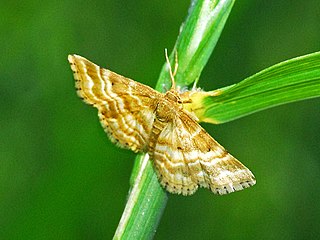
Emmiltis is a monotypic moth genus in the family Geometridae. Its only species is Emmiltis pygmaearia. Both the genus and species were first described by Jacob Hübner, the genus in 1825 and the species in 1809.
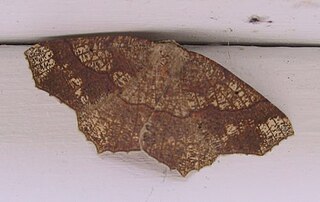
Besma quercivoraria, the oak besma, is a moth of the family Geometridae. The species was first described by Achille Guenée in 1857. It is found across southern Canada and all of the United States except California.
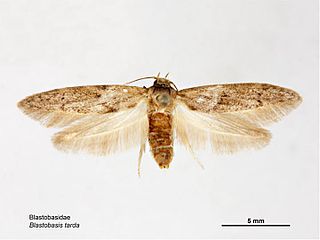
Blastobasis tarda is a moth of the family Blastobasidae. It is found in Australia in Queensland and New South Wales.. It is an introduced species in North America, where it has been found in southern California. It has also been reported from France. There is a species in New Zealand that is very similar in appearance to B. tarda that has yet to be formally described.

Parapoynx fluctuosalis or Fluctuating China-mark or Waved China-mark, is a moth of the family Crambidae. It is a widespread species, known from Africa, India, Sri Lanka, China, Japan, Malaysia, Taiwan, Guam, Hawaii, Fiji, Australia and the Galápagos Islands. It is also an introduced species in Europe, where it has been recorded from Great Britain, the Iberian Peninsula and Sardinia.

Epione vespertaria, the dark bordered beauty, is a moth of the family Geometridae.

Epipaschia superatalis, the dimorphic macalla moth, is a moth in the family Pyralidae. It is found in eastern North America.

Costaconvexa centrostrigaria, the traveller or bent-line carpet, is a moth in the family Geometridae. It is native to most of North America, except the Arctic. It is an introduced species in Great Britain, the Canary Islands, the Azores and Madeira.
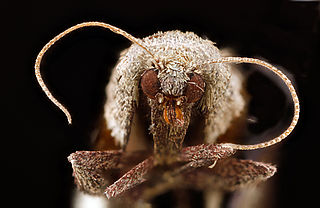
Tosale is a genus of snout moths. It was described by Francis Walker in 1859.

Ulochlaena hirta is a species of moth in the family Noctuidae first described by Jacob Hübner in 1813. It is found in south-eastern Europe and the Mediterranean region, east through Turkey, Iran and the Kopet Dag mountains to the southern Urals.
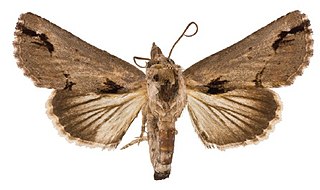
Paectes nana is a moth in the family Euteliidae. It is widespread from Florida through the Greater Antilles and from Mexico to Costa Rica. In South America, it is found in Venezuela, Colombia and northern Ecuador. It has been introduced to the Galapagos Islands.
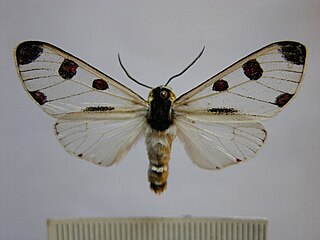
Dysschema boisduvalii is a moth of the family Erebidae first described by Jan van der Hoeven in 1840. It is found in Paraguay, Colombia, Brazil and Argentina.
Dysschema subapicalis is a moth of the family Erebidae first described by Francis Walker in 1854. It is restricted to the Atlantic forests of south-eastern Brazil.

Isotrias rectifasciana, the hedge shade, is a species of moth of the family Tortricidae found in Asia and Europe. The moth was first described by the English entomologist, Adrian Hardy Haworth in 1811.

Cnephasia longana, the omnivorous leaftier moth, long-winged shade or strawberry fruitworm, is a moth of the family Tortricidae. It was described by Adrian Hardy Haworth in 1811. It is native to western Europe. It is an introduced species in western North America. The species has also been reported from north-western Africa and Asia. The habitat consists of downland and rough ground.

Phtheochroa inopiana, the plain conch, is a species of moth of the family Tortricidae. It is found in China, Iran, Japan, Mongolia, Russia and most of Europe. It has also been recorded in North America. The habitat consists of damp areas and woodland edges.
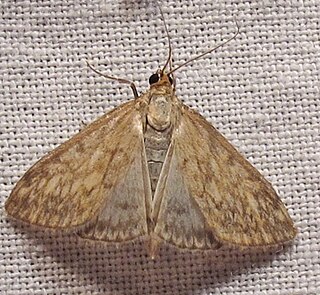
Sitochroa chortalis, the dimorphic sitochroa moth, is a moth in the family Crambidae. It was described by Augustus Radcliffe Grote in 1873. It is found in North America, where it has been recorded from Nova Scotia to southern British Columbia, south to New Jersey, Arizona and northern California. The habitat consists of grassland and prairie areas.




















